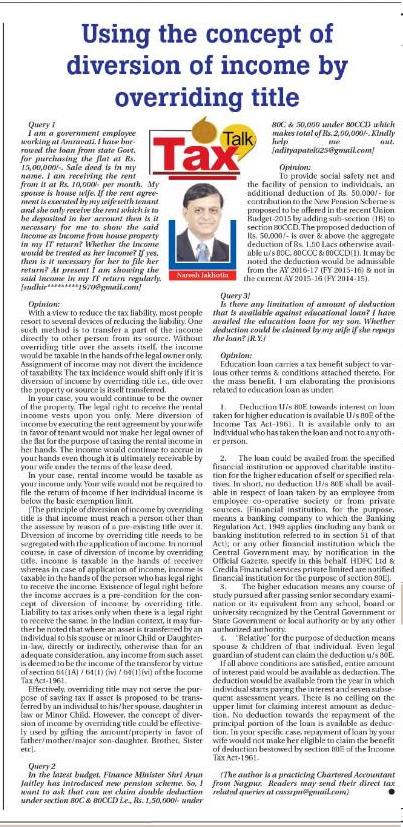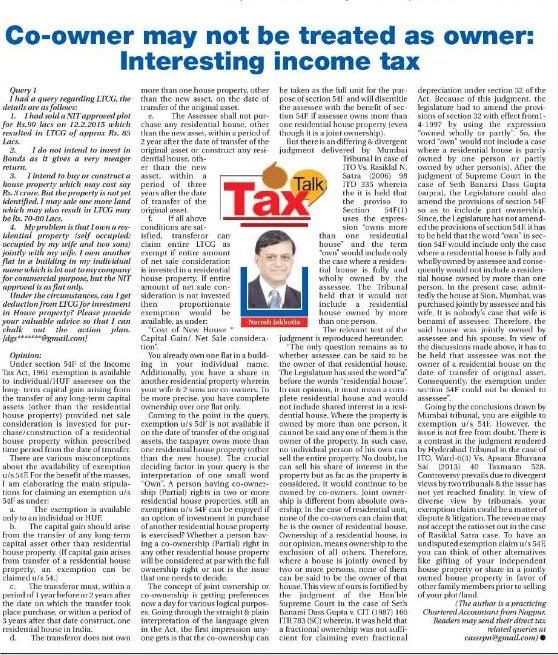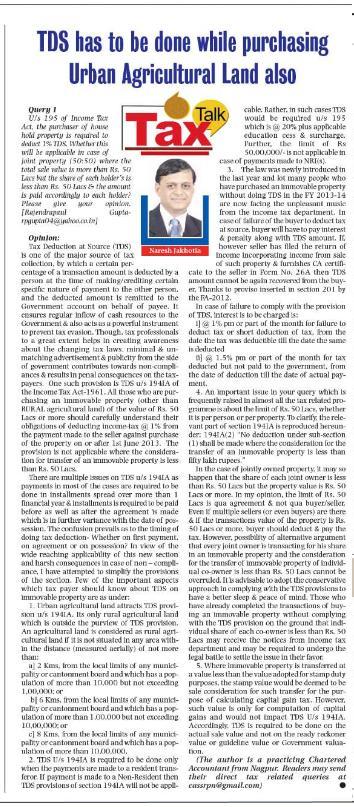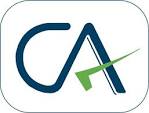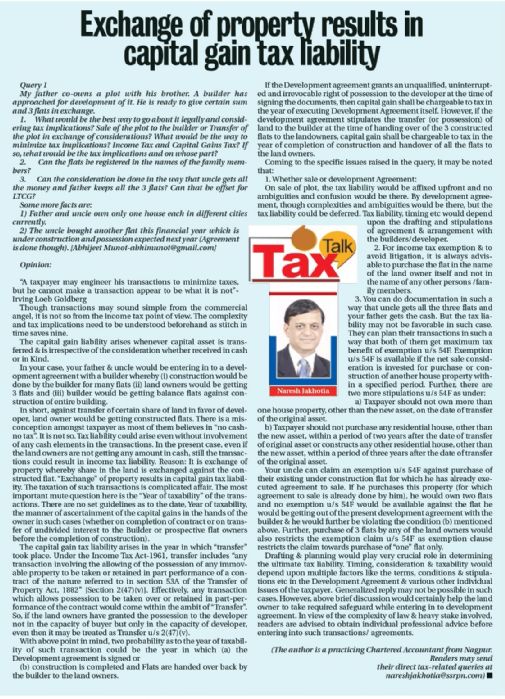Article Details
| New option for saving Long Term Capital Gain Tax |
|
TAX TALK-04.04.2016-THE HITAVADA TAX TALK CA. NARESH JAKHOTIA Chartered AccountantNew option for saving Long Term Capital Gain Tax Query 1] My agreement of sale for flat in a complex of 500 flat, with a builder was signed in Jan- 2011. The payments for the flat, 9 installments, were paid before 01/06/2013 when the sec came to force. The last and 10th installment was paid when the builder did the registration after delay of 29 months. The total cost paid for the flat was Rs. 42.50 Lacs including service tax, but the state Govt. while registering the flats, did a valuation of 64 lacks and based on which the IT has asked why TDS under the law was not deducted? The cost of the flat, even after the stamp duty and registration charges are included, does not exceed Rs. 50 Lacs? The section has not anything to do with valuation by the registering authority at a date subsequent to payment to builder/ transferor? Late delivery by builders is nowadays the norm. Is any tax due? [Soumo Roy-roysoumo@yahoo.co.in] Opinion: 1. Tax Deduction at Source (TDS) is one of the major source of tax collection, by which a certain percentage of a transaction amount is deducted by a person at the time of making payment or crediting certain specific nature of payment to the other person, and the deducted amount is remitted to the Government account on behalf of payee. It ensures regular inflow of cash resources to the Government & also acts as a powerful instrument to prevent tax evasion. 2. All the taxpayers who are purchasing an immovable property (other than prescribed RURAL agricultural land) of the value of Rs. 50 Lacs or more from resident person are duty bound [u/s 194IA] to deduct & remit income tax (i.e., TDS) @ 1% from the payment made to the seller against purchase of such property. Please note that TDS provision is not applicable where the consideration for transfer of an immoveable property is less than Rs. 50 Lacs. 3. Where immovable property is transferred at a value less than the value adopted for stamp duty purposes, the stamp duty value would be deemed to be sale consideration for such transfer for the purpose of calculating capital gain tax. However, such value is only for computation of capital gains and would not impact TDS U/s 194IA. TDS is required to be done on the actual sale value only and not on the ready reckoner value or guideline value or Government valuation.
In a lighter sense, one may note that there is no “unsubscribe” option in the mailing list of income tax department. Taxpayers who have purchased property of more than Rs. 50 Lacs without complying with the TDS provision U/s 194IA are now facing the unpleasant music from the income tax department. In case of failure of the buyer to deduct tax at source, buyer will have to pay interest & penalty along with TDS amount. However, purchaser could get a relief if the seller has filed the return of income incorporating income from sale of such property & furnishes CA certificate to the seller in Form No. 26A. In such case, the TDS amount cannot be recovered from the buyer. Thanks to proviso inserted in section 201 by the Finance Act-2012. Query 2] I request you to please suggest me if I can invest Rs. 50 Lacs in NHAI/REC Bonds and further invest the balance amount of capital gain of Rs. 50 Lacs in capital gain account( CGDAS) so as to avoid any tax liability. [Hiralal Lala, Bhopal, MP, India-lalahiralal@gmail.com] Opinion: 1. One can claim an exemption u/s 54F (purchasing/constructing a house property) & U/s 54EC (investing in REC/NHAI bonds) simultaneously. 2. Mere investment in the Capital Gain Deposit Account scheme (CGDAS) does not help in the blanket saving of capital gain tax. One needs to know the scheme of deposit in the CGDAS, as there appears to be some confusion amongst taxpayer about the idea behind CGDAS. 3. Scheme of Deposits in CGDAS: Although under section 54/54F, taxpayer is allowed a time period of 2 years for purchase & 3 years for construction of the house property from the date of sale of original assets. However, the capital gain on transfer of the assets is taxable in the year in which the transfer took place. The return of income of that previous year has to be filed before the due date. To offer the benefit of exemption at the time of filing the income tax return, Income Tax Act has specified a mechanism in the form of deposit under the CGDAS. The amount of the net sale consideration, which is not utilized by the taxpayer for purchase or constructions of the new house before the due date of furnishing the return of income, should be deposited by him in CGDAS, before the DUE DATE of furnishing the return. After deposits, the amount already utilized by the taxpayer for purchase/ constructions of the new house, along with the amount so deposited, shall be eligible for exemption under section 54/54F in the year in which LTCG has arisen. Subsequently, taxpayer has to utilize the amount for purchase / construction, as the case may be, within a specified period of 2 or 3 years by withdrawing from the account. If the amount is not utilized for investment then the amount not so utilized would be taxable as the capital gain of the year in which the period of 3 years expires. In short, non utilization of deposit in CGDAS makes the amount taxable at the end of 3 years. 4. If taxpayers don’t have plans to invest in house property for saving LTCG Tax [U/s 54 or 54F] then normally taxpayers have an open option u/s 54EC in the form of REC/NHAI Bonds, wherein the maximum ceiling of Rs. 50 Lacs is there. The recent union Budget has proposed one more option u/s 54EE. Taxpayer would now be able to save LTCG tax by investing the gain in units of notified specified funds, up to max of Rs. 50 Lacs. The investment u/s 54EE would also carry a three-year lock-in period and premature withdrawal will result in the tax benefits being reversed. In short, assessee earning LTCG after 01.04.2016, would be able to save tax u/s 54EC as well as u/s 54EE by investing Rs. 50 Lacs in each section (i.e., Total of Rs. 1 Cr could be invested now). [The author is a practicing Chartered Accountant from Nagpur. Readers may send their direct tax related queries at SSRPN & Co 10, Laxmi Vyankatesh Apartment C.A. Road, Telephone Exch. Square Nagpur-440008 or email it at nareshjakhotia@ssrpn.com] |
 |




.png)
